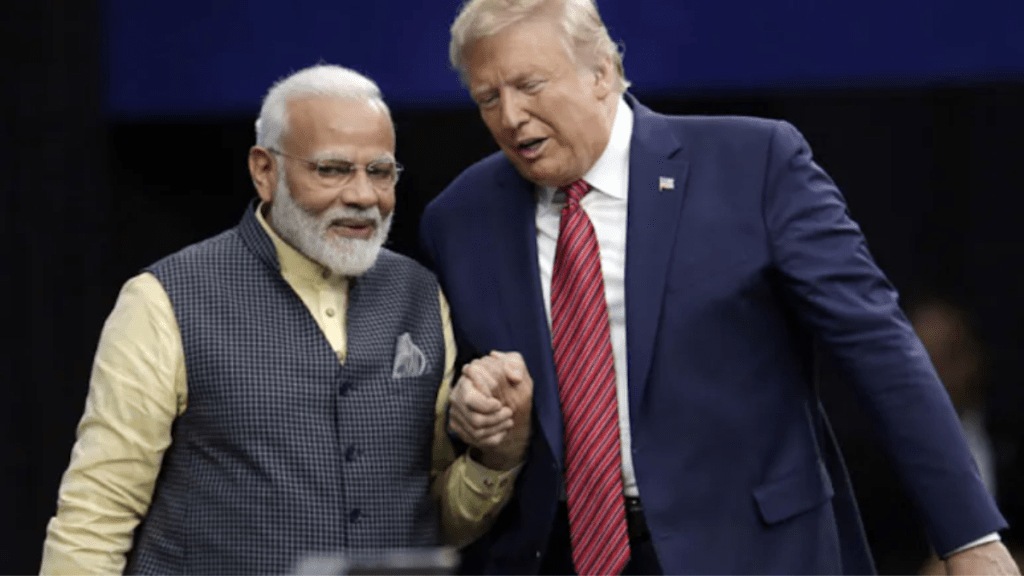While US President Donald Trump has reiterated his plans to impose reciprocal tariffs on India, economists believe that India is unlikely to receive harsh tariff announcements, considering India’s trade surplus position with the US. An analysis report by JM Financial said, “India’s trade surplus position with the US seems comfortable vis-à-vis that of Asian peers with the US; hence, we believe that harsh tariff announcements are unlikely. We expect the share of the US in crude oil and LNG imports to rise at the cost of Russia.”
According to the office of the United States Trade Representative (USTR), US total goods trade with India was an estimated $129.2 billion in 2024. US goods exports to India in 2024 were $41.8 billion, up 3.4 per cent ($1.4 billion) from 2023. US goods imports from India totaled $87.4 billion in 2024, up 4.5 per cent ($3.7 billion) from 2023. The US goods trade deficit with India was $45.7 billion in 2024, a 5.4 per cent increase ($2.4 billion) over 2023.
A widened trade deficit
India’s merchandise trade deficit in January widened marginally to $22.9 million from the normalised levels in the previous month, per the data released by the government earlier last week. “The widening trade deficit due to sluggish momentum in exports was aided by the normalisation in gold imports at $2.7 billion. We expect heightened uncertainty globally as the Trump administration transitions to reciprocal tariffs and away from standardised practices.” For FY25 till date, core imports continued to lag, hinting at the sluggish demand environment, while external demand remained resilient. Momentum in exports of engineering goods (-13.1 per cent MoM) and petroleum products (-27.6 per cent MoM), and imports of crude oil (-12 per cent MoM) weakened. While normalising gold imports ($2.7 billion, -43 per cent MoM) aided in restricting the deficit position, the brokerage firm said.
Bilateral trade between India & US
US is India’s largest trading partner with a share of 17.8 per cent while its share in India’s imports is restricted to 5.9 per cent and China takes the lead with a 14 per cent share, revealed JM Financial. The share of exports to the US has improved while that of imports has reduced in comparison to Trump’s previous tenure (FY19). Around 37 per cent of India’s exports to US are concentrated in Electronic goods (16.3 per cent), Drug formulations (10.5 per cent) and Jewellery (9.9 per cent), while Electronic goods (14.3 per cent), Petroleum products (9.8 per cent) and Coal, Coke (6.4 per cent) form 30 per cent of total imports from US. It is pertinent to note that, unlike in the Democrat regime, India’s trade surplus position with the US deteriorated during Trump’s previous term.
Uncertainty calling
From threats of blanket tariffs to reciprocal tariffs which would be decided on a country level after factoring in the likely impact of currency devaluation, subsidies, etc., there has been a transition in the announcements from the Trump administration. The latter will be time consuming, allowing countries to negotiate a favourable deal in the process. JM Financial said, “A cross-country comparison places India’s trade surplus position in 2024 with the US at a significantly comfortable level of $46 billion vs China ($295 billion) and Mexico ($172 billion). Hence, we don’t expect the Trump administration to be harsh in India’s case. Moreover, differentiated rates would be confusing and would heighten uncertainty as the US administration moves away from the standardised procedures set earlier.” India’s Finance Secretary had, earlier, indicated that imports of ‘very few products’ are charged at higher rates (>3 per cent), which are expected to be rationalised/sorted out in the near term.
Cushioning from services exports
Preliminary figures indicate that India’s services exports of $38.55 billion and imports of $18.22 billion continued to be resilient and culminated in a services surplus position of $20.3 billion in Jan’25 vs $15.2 billion in the previous month. Sequentially, growth in exports (4.6 per cent MoM) outpaced that in imports (2.5 per cent MoM). “We expect services surplus to average $15 billion/month, which implies an annual figure of $180 billion for FY25,” the brokerage firm maintained
CAD expected at 1.4% of GDP
While the actual tariff policy is expected to be milder than what was anticipated in the run-up to presidential elections in the US, JM Financial said that there seems to be a heightened uncertainty on a global level approaching, as the US administration transitions away from standardised tariff policies. “Although we think the $500 billion target set for India-US bilateral trade by FY30 is steep, India’s surplus position is relatively comfortable. We expect the share of the US in India’s crude oil and LNG imports will rise at the cost of Russia. Considering the resilience reflected in India’s trade activity during Apr-Jan’25, we moderate our trade deficit estimate to $275 billion for FY25, resulting in CAD at 1.4 per cent of GDP for FY25 as well as FY26.”
